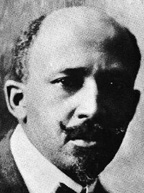
W. E. B. duBois 1868 - 1963

William Edward Burghardt DuBois was one of this country's most distinguished educators. Born in a small village in Massachusetts in 1868, DuBois first came face to face with the realities of racism in 19th century America while attending Fisk University in Nashville. It was while completing his graduate studies at Harvard that DuBois wrote an exhaustive study of the history of the slave trade -- one that is still considered one of the most comprehensive on that subject.
In 1895 he was the first African American to earn a Ph.D. from Havard University.
In 1897, DuBois took a position with Atlanta University. During his tenure there he conducted extensive studies of the social conditions of blacks in America. At the 1900 Paris World's Fair, DuBois created a full-scale exhibit of African American achievement since the Emancipation Procamation in industrial work, literature, and journalism. It included photodocumentation on educational institutions such as Tuskeegee, Fisk, and Howard. Congress approved of $15,000 for installation, and it was installed - off midway and in the Social Economy section of the Liberal Arts building where it languished compared with the negative Midway exhibits.
In 1903 he wrote The Souls of Black Folk (which may be read online here) which serves as the underpinning of access to many of his ideas.
In 1905 W.E.B. Dubois, John Hope, Monroe Trotter and 27 others met secretly in the home of Mary B. Talbert, a prominant member of Buffalo's Michigan Street Baptist Church, to adopt the resolutions which lead to the founding of the Niagara Movement. The Niagara Movement will renounce Booker T. Washington's accommodation policies set forth in his famed "Atlanta Compromise" speech ten years earlier. The Niagara Movement's manifesto is, in the words of Du Bois, "We want full manhood suffrage and we want it now.... We are men! We want to be treated as men. And we shall win." The movement will be a forerunner of the NAACP.
Despite the establishment of 30 branches and the achievement of a few scattered civil-rights victories at the local level, the group suffered from organizational weakness and lack of funds as well as a permanent headquarters or staff, and it never was able to attract mass support. After the Springfield (Ill.) Race Riot of 1908, however, white liberals joined with the nucleus of Niagara "militants" and founded the NAACP the following year, 1909. The Niagara Movement disbanded in 1910, with the leadership of Du Bois forming the main continuity between the two organizations.
Throughout the first half of the 20th Century, W.E.B. DuBois continued to work as an author, lecturer and educator. His teachings were an important influence on the Civil Rights Movement of the'50s and'60s. Ironically, DuBois died on the eve of the historic march on Washington in 1963. Actor and playwright Ossie Davis read an announcement of his death to the 250,000 people gathered the next day at the Washington Monument.
![]()
The following is excerpted from the chapter "Of Our Spiritual Strivings" in duBois' book The Souls of Black Folk.
On Double Consciousness
by W. E. B. duBois
After the Egyptian and Indian, the Greek and Roman, the Teuton and Mongolian, the Negro is a sort of seventh son, born with a veil, and gifted with second-sight in this American world,--a world which yields him no true self-consciousness, but only lets him see himself through the revelation of the other world. It is a peculiar sensation, this double-consciousness, this sense of always looking at one's self through the eyes of others, of measuring one's soul by the tape of a world that looks on in amused contempt and pity. One ever feels his twoness,--an American, a Negro; two warring souls, two thoughts, two unreconciled strivings; two warring ideals in one dark body, whose dogged strength alone keeps it from being torn asunder.
The history of the American Negro is the history of this strife,--this longing to attain self-conscious manhood, to merge his double self into a better and truer self. ...
![]()
BACK TO the African American History of Western New York
|
Since 4/96, |
|
visitors to the African American History of Western New York. |
|||